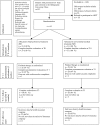Comparison of a biopsychosocial therapy (BT) with a conventional biomedical therapy (MT) of subacute low back pain in the first episode of sick leave: a randomized controlled trial
- PMID: 16311751
- PMCID: PMC3233941
- DOI: 10.1007/s00586-005-0008-5
Comparison of a biopsychosocial therapy (BT) with a conventional biomedical therapy (MT) of subacute low back pain in the first episode of sick leave: a randomized controlled trial
Abstract
This randomized controlled clinical trial compares the effectiveness of a biopsychosocial treatment with a solely conventional biomedical therapy in patients with subacute low back pain using parameters for pain intensity, functional status, depressive dysfunction and work performance. Sixty-four patients with a first-time sick leave between 3 and 12 weeks due to low back pain were randomly assigned to either a conventional biomedical therapy (MT; n=33) group, or a biopsychosocial therapy (BT; n=31) group including a psychotherapeutic module; both in accordance with a standardized 3 weeks inpatient treatment. Pain intensity, functional back capacity, clinical parameters and depressive dysfunction revealed significant improvement in both treatment groups at end of 3 weeks therapy (T1). However, at 6 months (T2), analysis revealed significant better results for nearly all parameters in the BT group that showed further improvement from T1 to T2, whereas the values in the MT group deteriorated from T1 back to the baseline values. During the 2-year period after therapy, 10% in MT and 59% in BT required no further sick leave due to low back pain. The results of the study indicate that a psychotherapeutic element in the treatment of low back pain appears to positively influence pain, functional status and work performance when conducted at an early stage of chronification and helps in the achievement of a better outcome.
Figures




References
-
- Alaranta H, Rytokoski U, Rissanen A, et al. Intensive physical and psychosocial training program for patients with chronic low back pain. A controlled clinical trial. Spine. 1994;19:1339–1349. - PubMed
-
- Bendix AF, Bendix T, Lund C, et al. Comparison of three intensive programs for chronic low back pain patients: a prospective, randomized, observer-blinded study with one year follow-up. Scand J Rehab Med. 1997;29:81–89. - PubMed
-
- Bortz J, Döring N. Forschungsmethoden und Evaluation. Berlin Heidelberg New York: Springer; 2002.
Publication types
MeSH terms
LinkOut - more resources
Full Text Sources

